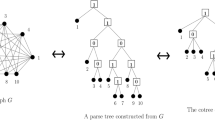Abstract
A co-bipartite chain graph is a co-bipartite graph in which the neighborhoods of the vertices in each clique can be linearly ordered with respect to inclusion. It is known that the maximum cardinality cut problem (\({\textsc {MaxCut}}\)) is \({\textsc {NP}}{\text {-hard}}\) in co-bipartite graphs (Bodlaender and Jansen, Nordic J Comput 7(2000):14–31, 2000). We consider \({\textsc {MaxCut}}\) in co-bipartite chain graphs. We first consider the twin-free case and present an explicit solution. We then show that \({\textsc {MaxCut}}\) is polynomial time solvable in this graph class.



Similar content being viewed by others
Notes
This is the only fact about treewidth used in this work.
References
Barahona F, Grötschel M, Jünger M, Reinelt G (1988) An application of combinatorial optimization to statistical physics and circuit layout design. Oper Res 36(3):493–513
Beineke LW (1970) Characterizations of derived graphs. J Comb Theory 9(2):129–135
Bodlaender HL, Jansen K (2000) On the complexity of the maximum cut problem. Nordic J Comput 7(2000):14–31
Boyacı A, Ekim T, Shalom M, Zaks S (2014) Graphs of edge-intersecting and non-splitting one bend paths in a grid (submitted)
Díaz J, Kamiński M (2007) Max-cut and max-bisection are NP-hard on unit disk graphs. Theor Comput Sci 377(13):271–276
Guruswami V (1999) Maximum cut on line and total graphs. Discret Appl Math 92(23):217–221
Hadlock F (1975) Finding a maximum cut of a planar graph in polynomial time. SIAM J Comput 4(3):221–225
Hammer PL, Peled UN, Sun X (1990) Difference graphs. Discret Appl Math 28(1):35–44
Heggernes P, Kratsch D (2007) Linear-time certifying recognition algorithms and forbidden induced subgraphs. Nordic J Comput 14(1–2):87–108
Karp RM (1972) Reducibility among combinatorial problems. In: Miller R, Thatcher J, Bohlinger J (eds) Complexity of computer computations. The IBM research symposia series. Springer, New York, pp 85–103
WA LLC (2015) Wolfram—alpha. http://tinyurl.com/qabptkt. Accessed March 2015
WA LLC (2015) Wolfram—alpha. http://tinyurl.com/pyxvpaq. Accessed March 2015
WA LLC (2015) Wolfram—alpha. http://tinyurl.com/ofa4h4c. Accessed March 2015
Yannakakis M (1981) Node-deletion problems on bipartite graphs. SIAM J Comput 10(2):310–327
Acknowledgments
This work is supported in part by TUBITAK Career Project Grant Nos. 111M482, and TUBITAK 2221 Program.
Author information
Authors and Affiliations
Corresponding author
Rights and permissions
About this article
Cite this article
Boyacı, A., Ekim, T. & Shalom, M. The maximum cardinality cut problem in co-bipartite chain graphs. J Comb Optim 35, 250–265 (2018). https://doi.org/10.1007/s10878-015-9963-x
Published:
Issue Date:
DOI: https://doi.org/10.1007/s10878-015-9963-x




